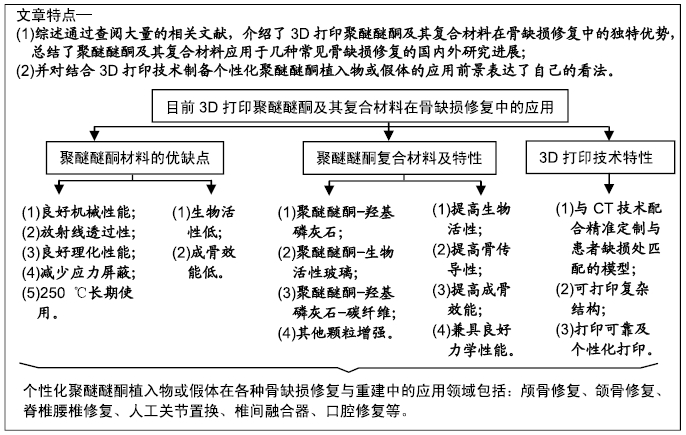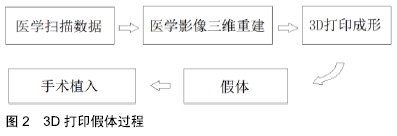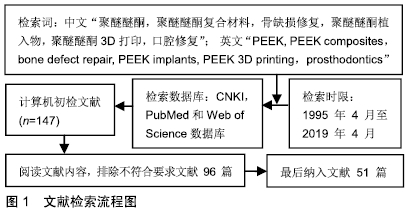[1] FU GT, LIU HJ, ZHANG B, et al. Characteristics and applications of peeks. Eng Plast Appl. 2006;34(10):69-71.
[2] KURTZ SM, DEVINE JN. PEEK biomaterials in trauma, orthopedic, and spinal implants. Biomaterials. 2007;28(32):4845-4869.
[3] ROSKIES MG, FANG D, ABDALLAH MN, et al. Improving PEEK bioactivity for craniofacial reconstruction using a 3D printed scaffold embedded with mesenchymal stem cells. Appl Biomater. 2016;31(1): 132-139.
[4] NAJEEB S, ZAFAR MS, KHURSHID Z, et al. Applications of polyetheretherketone (PEEK) in oral implantology and prosthodontics. J Prosthodont Res. 2015;60(1):12-19.
[5] WONG TM, JIN J, LAU TW, et al. The use of three-dimensional printing technology in orthopaedic surgery: a review. J Orthop Surg. 2017;25(1):1-7.
[6] 刘吕花,郑延延,张丽芳,等.硬组织植入生物活性聚醚醚酮复合材料[J].化学进展, 2017,29(4):450-458.
[7] SADAT-SHOJAI M, KHORASANI MT, DINPANAH-KHOSHDARGI E, et al. Synthesis methods for nanosized hydroxyapatite with diverse structures. Acta Biomater. 2013;9(8):7591-7621.
[8] WALSH WR, PELLETIER MH, BERTOLLO N, et al. Does PEEK/HA enhance bone formation compared with PEEK in a sheep cervical fusion model?. Clin Orthop Relat R. 2016;474(11):2364-2372.
[9] KAUR G, PANDEY OP, SINGH K, et al. A review of bioactive glasses: Their structure, properties, fabrication and apatite formation. J Biomed Mater Res A. 2014;102(1):254-274.
[10] 郑延延,刘吕花,韩崇涛,等.聚醚醚酮/碳纳米管/生物活性玻璃复合材料的成骨细胞相容性研究[J].川北医学院学报,2017,32(4):7-10.
[11] SHARMA M, BIJWE J, MADER E, et al. Strengthening of CF/PEEK interface to improve the tribological performance in low amplitude oscillating wear mode. Wear. 2013;301(1):735-739.
[12] 冯惺,隋国鑫,杨锐. PEEK-HA-CF复合材料的力学性能和体外生物活性[J]. 材料研究学报,2008,22(1):18-25.
[13] WU X, LIU X, WEI J, et al. Nano-TiO2/PEEK bioactive composite as a bone substitute material: in vitro and in vivo studies. Int J Nanomed. 2012;7:1215-1225.
[14] KUO MC, TSAI CM, HUANG JC, et al. PEEK composites reinforced by nano-sized SiO2 and Al2O3 particulates.Mater Chem Phys.2005;90(1): 185-195.
[15] 赵靖,王笛,刘继全,等. 3D打印技术在医学领域应用的现状及问题[J]. 中国现代医学杂志, 2017,27(12):71-74.
[16] 袁浩天,时舒曼,张晓晓,等.利用CT数据构建3D打印骨组织工程支架材料[J]. 实用医学杂志,2016,32(14):2319-2322.
[17] 李涤尘,杨春成,康建峰,等.大尺寸个体化PEEK植入物精准设计与控性定制研究[J].机械工程学报,2018,54(23):121-125.
[18] 史长春,胡镔,陈定方,等.聚醚醚酮3D打印成形工艺的仿真和实验研究[J]. 中国机械工程, 2018,29(17):2119-2124.
[19] KELLY CP, COHEN AJ, YAVUZER R, et al. Cranial bone grafting for orbital reconstruction: is it still the best? J Craniofac Surg. 2005;16(1): 181-185.
[20] PANAYOTOV IV, ORTI V, CUISINIER F, et al. Polyetheretherketone (PEEK) for medical applications. J Mater Sci-Mater M. 2016;27(7):118.
[21] LETHAUS B, SAFI Y, TER LM, et al. Cranioplasty with customized titanium and PEEK implants in a mechanical stress model. J Neurotraum. 2012;29(6):1077-1083.
[22] 冀培刚,刘竞辉,李宝福,等.聚醚醚酮材料在颅骨缺损后修补中的应用[J]. 临床医学研究与实践, 2018,3(26):7-8,11.
[23] 张国斌,张述升,靳峥,等. 以聚醚醚酮植入体行颅骨缺损成形术的初步研究[J].天津医药, 2017,45(8):806-809,897.
[24] 陈天杰,刘红,刘称称,等. 聚醚醚酮复合材料在口腔医学领域中的应用[J]. 现代口腔医学杂志, 2017,31(6):364-367.
[25] JACOBS CA, LIN AY. A new classification of three-dimensional printing technologies: systematic review of three-dimensional printing for patient-specific craniomaxillofacial surgery. Plast Reconstr Surg. 2017; 139(5):1211-1220.
[26] 李劲松. 3D打印聚醚醚酮(PEEK)假体精确重建眶底缺损的疗效分析[C]. 第十四次中国口腔颌面外科学术会议论文汇编. 北京:中华口腔医学会, 2018:541-542.
[27] GOODSON ML, FARR D, KEITH D, et al. Use of two-piece polyetheretherketone (PEEK) implants in orbitozygomatic reconstruction. Brit J Oral Max Surg. 2012;50(3):268-269.
[28] 韩明林,李明贺,及昕,等.兔颞下颌关节突缺损模型的建立和CFR-PEEK材料人造关节的修复效果评价[J]. 吉林大学学报(医学版),2017,43(5): 903-909.
[29] BERRONE M, ALDIANO C, PENTENERO M, et al. Correction of a mandibular asymmetry after fibula reconstruction using a custom-made polyetheretherketone (PEEK) onlay after implant supported occlusal rehabilitation. Acta Otorhinolaryngo. 2015;35(4): 285-288.
[30] 边卫国,张银刚,刘亮,等. 3D打印聚醚醚酮人工椎板在腰椎后路椎板减压术中的初步运用[J]. 风湿病与关节炎,2017,6(8):46-47.
[31] LAUX CJ, HODEL SM, FARSHAD M, et al. Carbon fibre/polyether ether ketone (CF/PEEK) implants in orthopaedic oncology. World J Surg Oncol. 2018;16(1):241-246.
[32] 李世梁,连育才,孙海东,等. PEEK棒与钛棒治疗腰椎管狭窄症的疗效对比[J]. 中国矫形外科杂志,2018,26(11):983-987.
[33] NOROTTE G, BARRIOS C. Clinical and radiological outcomes after stand-alone ALIF for single L5-S1 degenerative discopathy using a PEEK cage filled with hydroxyapatite nanoparticles without bone graft. Clin Neurol Neurosurg. 2018;168:24-29.
[34] 王琪,刘军,王亚楠,等. 3D打印技术在脊柱肿瘤手术中的应用[J]. 解放军医药杂志, 2016,28(11):16-19.
[35] 卢祺,于滨生. 脊柱内植物的3D打印技术研究进展[J]. 中国修复重建外科杂志, 2016,30(9):1160-1165.
[36] CHEN Y, WANG X, LU X, et al. Comparison of titanium and polyetheretherketone (PEEK) cages in the surgical treatment of multilevel cervical spondylotic myelopathy: a prospective, randomized, control study with over 7-year follow-up. Eur Spine J. 2013;22(7): 1539-1546.
[37] 朱明智.颈椎前路椎间盘切除减压后应用桥式自锁定聚醚醚酮椎间融合器治疗颈椎病的临床疗效[J].临床医学,2017,37(3):89-91.
[38] LEMCKE J, ALZAIN F, MEIER U, et al. Polyetheretherketone (PEEK) spacers for anterior cervical fusion: a retrospective comparative effectiveness clinical trial. Open Orthop J. 2011;5(1):348-353.
[39] 曹盛生,饶敏杰,秦育宏,等. 前路颈椎间盘桥式自锁定PEEK椎间融合器的临床应用及中远期疗效研究[J]. 中国全科医学, 2017,20(5):603-606.
[40] 王俊元,段晨曦,杜文华,等. 交叉剪切对人工关节应用中PEEK和 CFR- PEEK 磨损的影响[J]. 中国生物医学工程学报, 2019,38(1):125-128.
[41] RUITER LD, JANSSEN D, BRISCOE A, et al. A preclinical numerical assessment of a polyetheretherketone femoral component in total knee arthroplasty during gait. J Exp Orthop. 2017;4(1):3.
[42] RANKIN KE, DICKINSON AS, BRISCOE A, et al. Does a PEEK femoral TKA implant preserve intact femoral surface strains compared with CoCr? A preliminary laboratory study. Clin Orthop Relat R. 2016; 474(11):2405-2413.
[43] 纪志华,贾丙申,周立义,等.置入碳纤维增强聚醚醚酮股骨头假体稳定性的生物力学分析[J].中国组织工程研究,2017,21(15):2325-2330.
[44] NAJEEB S, ZAFAR MS, KHURSHID Z, et al. Applications of polyetheretherketone (PEEK) in oral implantology and prosthodontics. J Prosthodont Res. 2016;60(1):12-19.
[45] ROSENTRITT M, PREIS V, BEHR M, et al. Shear bond strength between veneering composite and PEEK after different surface modifications. Clin Oral Invest. 2015;19(3):739-744.
[46] LEE WT, KOAK JY, LIM YJ, et al. Stress shielding and fatigue limits of poly-ether-ether-ketone dental implants. J Biomed Mater Res B. 2012; 100(4):1044-1052.
[47] MOUNIR M, ATEF M, ABOU-ELFETOUH A, et al. Titanium and polyether ether ketone (PEEK) patient-specific sub-periosteal implants: Two novel approaches for rehabilitation of the severely atrophic anterior maxillary ridge. Int J Oral Max Surg. 2018;47(5):658-664.
[48] 金智文,韩建民,刘云松,等. 聚醚醚酮制作可摘义齿人工牙耐磨性及硬度的研究[J]. 口腔颌面修复学杂志, 2018,19(4):236-240.
[49] SKIRBUTIS G, DZINGUTE A, MASILIUNAITE V, et al. A review of PEEK polymer's properties and its use in prosthodontics. Stomatologija. 2017;19(1):19-23.
[50] LONDONO J, TADROS M, SALGUEIRO M, et al. Digital design and 3D printing of an implant-supported prosthetic stent for protecting complete arch soft tissue grafts around dental implants: A dental technique. J Prosthet Dent. 2018;120(6):801-804.
[51] HALEEM A, JAVAID M. Polyether ether ketone (PEEK) and its manufacturing of customised 3D printed dentistry parts using additive manufacturing. Clin Epidemiol Glob Health. 2019. doi:10.1016/j.cegh.2019.03.001.
|



